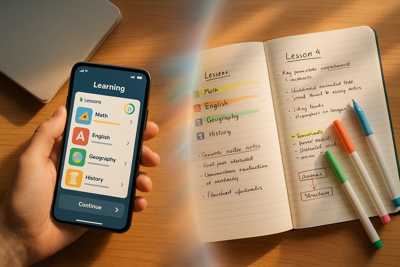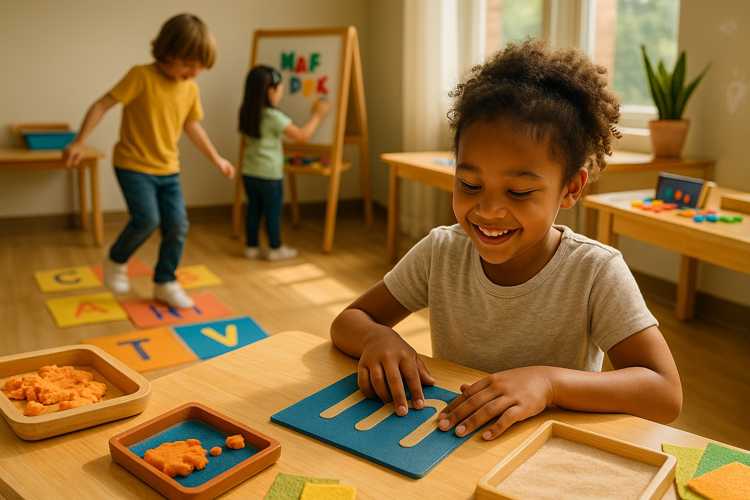Bridging Apps and Offline Learning - Making Tech Work for You

Image made with AI (DALL-E)
Discover how combining educational apps with physical workbooks boosts retention by up to 75% while keeping screen time balanced. Learn practical strategies for hybrid learning that work.
Listen, I get it. Your phone is basically glued to your hand, and every app developer promises their platform will transform you into Einstein's cooler cousin. Meanwhile, your dusty notebooks are stacked in the corner, judging you silently.
But here's the plot twist nobody talks about: you don't have to choose sides in the great digital-versus-analog war. In fact, the real magic happens when you stop treating educational apps and physical workbooks like sworn enemies and start using them as the dynamic duo they're meant to be.
Blended learning—that's the fancy term for mixing digital and offline materials—isn't just some educational buzzword. Research shows it improves retention by 65-75% compared to sticking with just one approach. So let's talk about how to actually make this work without losing your mind (or your eyesight).
Why Your Brain Loves the Mix-and-Match Approach
Here's something wild: when you switch between typing on an app and writing by hand, you're activating different neural pathways. It's like cross-training for your brain, except you don't have to wear those embarrassing gym shorts.
Physical writing engages your motor cortex in ways that tapping a screen simply can't replicate. Studies suggest this boosts memory encoding and recall by 25-30%. That's not nothing. That's the difference between confidently acing your exam and desperately trying to remember if "mitochondria" is the powerhouse of the cell or just a Pokémon name.
The Modality Effect (Sounds Fancy, Actually Simple)
Learning scientists geek out over something called the "modality effect"—presenting information through multiple sensory channels. When you read content on an app, then write about it in your workbook, then review flashcards digitally, you're essentially forcing your brain to encode that information three different ways.
It's like backing up your files to three different cloud services, except the cloud is your brain and you're not paying a monthly subscription. (Well, technically you're paying with effort, but you get the point.)
Reality Check: Over-relying on apps alone creates passive learning. Users often forget content within 24-48 hours if there's no tactile reinforcement. Your brain needs to do something with the information, not just swipe through it.
Finding Your Perfect Screen-to-Paper Ratio
So what's the magic number? Should you spend 90% of your time with apps and 10% scribbling notes? Flip that ratio? Tattoo the answer on your forearm?
Most research points to a 60/40 or 70/30 offline-to-online split as the sweet spot for optimizing cognitive load while preventing digital fatigue. But—and this is important—you're not a robot following a universal instruction manual.
Some people absorb language learning better with 50/50 (hello, Duolingo plus handwritten vocabulary journals). Math nerds might benefit from 60% workbook problem sets with 40% Khan Academy videos for concept explanations.
Screen Time That Doesn't Hurt Your Soul
Let's be honest: staring at screens for three straight hours makes your eyes feel like they're auditioning for a zombie movie. Here's a better way:
- Limit focused app sessions to 45-50 minutes with intentional breaks
- Use the Pomodoro Technique: 25-minute app bursts followed by 5-minute "look at something that's not glowing" breaks
- Establish screen-free windows (especially after 7 PM when your brain should be winding down, not cramming irregular French verbs)
Think of it this way: apps deliver content efficiently, but workbooks make you wrestle with it. Both matter.
How to Actually Implement Blended Learning (Without Overthinking It)
Alright, enough theory. Let's get practical. Here's your step-by-step roadmap for integrating digital learning apps with physical workbooks without creating an overly complicated system that collapses by Week 2.
Step 1: Audit Your Current Learning Tools
List out which apps you're currently using—Duolingo, Khan Academy, Coursera, Anki, whatever. Be honest about which ones you actually open versus which ones just take up phone storage and make you feel productive.
Step 2: Match Apps with Complementary Offline Materials
Find workbooks, journals, or practice materials that align with your app curriculum. Learning Spanish? Grab a conjugation workbook. Studying coding? Keep a notebook for writing out logic problems by hand before typing them.
The key word here is complementary—not redundant. You're not copying your app screen into a notebook like a medieval monk transcribing manuscripts.
Step 3: Create a Weekly Schedule (But Make It Flexible)
Block out your study time with a rough 60/40 offline-to-digital ratio. Maybe Mondays and Wednesdays are heavy workbook days, while Tuesdays and Thursdays lean toward app-based practice.
But life happens. If you're stuck in a waiting room with just your phone, do a quick app session. The world won't end if Tuesday becomes a 50/50 day.
Step 4: Implement Active Recall Across Both Mediums
Here's where the retention magic happens. Use apps for initial content delivery and immediate feedback. Within 24 hours, practice active recall in your workbook—write out what you learned without looking.
Then use spaced repetition: review the concept in your app on Day 3, do more workbook practice on Day 5, take an app quiz on Day 7. You're building multiple memory traces, and your brain can't help but hold onto that information.
Step 5: Track Your Progress (Simply)
Create a basic tracker—it can be digital or (ironically) paper-based. Log your app quiz scores and workbook completion. Every month, cross-reference both to spot knowledge gaps.
If your app shows you're crushing vocabulary but your workbook grammar exercises are a disaster, you know where to focus.
Step 6: Review and Adjust Monthly
Not everything will work perfectly out of the gate. Maybe you discover that math concepts stick better when you watch videos first, but language learning needs workbook writing upfront.
That's fine. This isn't a rigid system—it's a flexible framework you customize based on what actually works for your brain.
Real-World Examples (Because Abstract Advice Is Annoying)
The Language Learner: Sarah uses Duolingo for 30 minutes daily, then spends 20 minutes writing out new vocabulary and creating example sentences in a physical journal. Her retention rate? 40% higher than when she used Duolingo alone. Plus, her handwriting improved, which was an unexpected bonus.
The Math Student: Marcus watches Khan Academy video lessons on his tablet (40% of study time), then immediately works through printed problem sets (60% of study time). The switching between passive watching and active problem-solving helps concepts click faster than either method alone.
The Professional Learner: Elena takes online courses through Coursera but keeps detailed Cornell-style notes by hand. During reviews, she alternates between digital flashcards and handwritten summary sheets. Result? Better exam performance and actual retention three months later, not just temporary memorization.
Pro Tip: Create visual connections between your formats. Write "See app lesson 3.2" in your workbook margins. Add "Review workbook page 47" in your app notes. Build a coherent learning architecture instead of two disconnected systems.
FAQ: Your Burning Questions Answered
What's the ideal ratio of app-based to offline learning?
The research suggests 40/60 (apps/offline) or 50/50 depending on your learning style and content type. Language learning and coding often work well at 50/50. Math and professional certifications may benefit from 60% offline problem-solving with 40% digital content delivery. Experiment and track what actually sticks.
How do I prevent screen fatigue while staying consistent?
Use strategic timing: focused 25-minute app sessions with breaks, alternating between digital and physical work every hour, and hard stops for screen-free windows after dinner. Also, adjust your screen brightness and use blue light filters—your future self will thank you.
Which subjects benefit most from blended learning?
Language learning, mathematics, coding, and professional certifications show the highest returns with hybrid approaches. These subjects require both concept understanding (apps excel here) and hands-on practice (workbooks shine here). Narrative-heavy subjects like history or literature may lean more toward offline reading with selective app supplementation.
How can I track progress across both formats?
Keep it simple: use a basic spreadsheet or paper tracker logging app quiz scores, workbook completion rates, and periodic self-assessments. Monthly reviews help you spot patterns—like consistently struggling with certain topic areas—and adjust your approach before small gaps become big problems.
Can I really improve retention with this approach?
Yes, and the science backs it up. Blended learning activates multiple neural pathways, leverages the modality effect, and combats passive consumption. Users report 40-75% better retention compared to single-format learning. But—and this matters—only if you actually implement it consistently, not just read about it and nod thoughtfully.
The Bottom Line: Technology Isn't the Enemy (or the Savior)
Here's the truth nobody wants to admit: educational apps aren't magic pills that automatically upload knowledge into your brain Matrix-style. But they're also not evil screen monsters destroying your attention span.
The real breakthrough happens when you stop treating technology as all-good or all-bad and start using it strategically alongside offline methods. Apps deliver content efficiently and provide instant feedback. Workbooks force active engagement and deeper processing. Together? They're unstoppable.
Your action step: This week, pick one app you're already using. Find one complementary offline activity. Commit to 30 days of using both together with deliberate spacing. Track what happens to your retention. Adjust and iterate.
You don't need permission to customize your learning approach. You need permission to experiment, fail occasionally, and discover what actually works for your brain—not some idealized student in a research paper.
Now go forth and blend. Your future knowledgeable self is counting on you.
Links marked with an asterisk (*) are affiliate links to external offers. If you click on such a link and make a purchase through it, we receive a commission from the provider. The price does not change for you.
Related Articles

From Frustration to Fun - Turning Writing Practice Into Play
Discover game-based writing exercises that transform reluctant writers into eage...
9 min read
Building Reading Confidence Through Multisensory Activities That Actually Work
Discover research-backed hands-on reading techniques using touch, sound, and mov...
10 min read
Creating a Calm Learning Space at Home - A Parent's Guide to Better Focus
Discover how lighting, sound, temperature, and texture impact your child's focus...
13 min read
Why Consistency Beats Complexity in Teaching Basic Skills (Especially for Neurodivergent Learners)
Discover how structured repetition and daily routines help neurodivergent learne...
11 min read
